
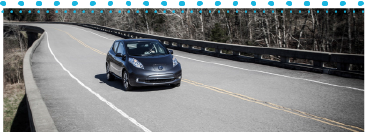
To truly understand what your customer is trying to describe is difficult sometimes. Without the experience of driving an electric vehicle on a daily basis, it can be hard to commiserate with them over possibly normal vehicle operations they may not understand — or the anxiety they may have over possibly running out of power. Unless you have driven distances that challenge the capacity of an electric vehicle’s battery on a daily basis, and over an extended period of time, you may not completely understand the unique needs of electric vehicles or appreciate certain driving styles acquired from some seasonal commutes. These unique needs start with having to charge a battery sometime between drives, and even possibly adopting a very conservative driving style that may include driving without the heater or air conditioning on if drive distance is the goal.
The only way to convey a few of those unique needs is to give you a glimpse into the daily drive of a LEAF® that has driven through all four seasons (your seasons and drive pattern may vary) and tell the story from a LEAF’s perspective. This LEAF®, whose name is Silver Maple Leaf, took it upon herself to push the envelope on a daily basis. To risk the dreaded “Turtle Mode,” while constantly being nagged by range anxiety and is able to leap tall buildings in a single bound…well not really, but seriously let’s hear about her experience over the last year.
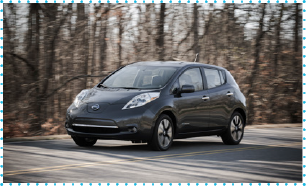
Before I tell my story, I’ll first mention the obvious: As we all know, the more power that I demand from my battery, the faster I will discharge, and the amount of energy that I can store on a recharge is finite. I guess humans aren’t much different since they also have to eat on a regular basis and can only eat so much; we aren’t too different at least in that respect. Since you may be able to store more or less in your battery, I will give you a few tips that may be helpful when you are driving with your human.
Since winter driving with the heater on reduces my driving range the most, I will focus on a winter commute. My drive to and from my human’s workplace starts with being plugged in the night before, after I get back to my garage; my human doesn’t want to forget to plug me in. After charging, I reassure my human with a TXT to his smartphone, usually sometime before his bedtime, if I can. –Yawn– (or is that beep?), a new day has arrived. My human has checked the morning temperature with his smartphone … a 25°F winter morning. Through my smartphone app, my human has turned on my climate control to warm (precondition) my interior. This is not really something that I require, but my human seems to think that it really is a necessity for their commute because of the distance traveled. This may leave me without enough juice to get home, if the heat was on for the entire trip (please don’t mention a rollback in polite LEAF® company). So the interior is preheated and at points during my commute my defroster is turned on and off as needed to clear the windows. Turning the defroster on and off has been elevated to an art form and can vary with the humidity and temperature of the day. Just takes a little human fiddling and practice with the climate control buttons to achieve the desired results.
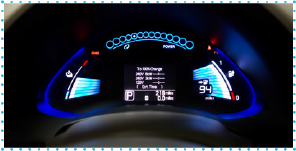
We are ready to go. As with many cold mornings, this morning my human has bundled up more than usual and is wearing gloves. I am unplugged, and down the road we go. Since I started being driven a year ago, my ECO mode has always been used while driving. My human seems to think that it is easier to control the accelerator pedal pressure and that there is more deceleration braking and/or power regeneration. Now it may be that your human passengers might feel differently, since no two of them seem to be the same. The route is initially hilly (about 3,000 feet of elevation gain for a two-way trip) with lots of twists and bends in the road that eventually transitions into a gently meandering 55-60 mph, two-lane country drive. It’s odd, but driving through the tight twisty roads seems to give my human some sort of pleasure. As we drive during this time of year, my battery state of charge drops more quickly with the lower temperatures, so my human takes extra care to use as little accelerator pedal as possible as we make our way. Very rarely do I go over three power segments in the combination meter to accelerate from a stop, and my speeds are kept “at or below” the posted speed limit. Not necessarily because my human is “green,” but because it may be the difference of whether or not I get home on a single charge. Now don’t feel sorry for me, I can be charged at my human’s work if needed.
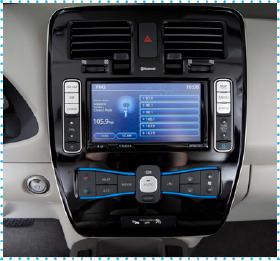
As with many regions, the weather can vary widely from the morning to the evening and could go from snow in the morning to a bright, clear, warm day in the afternoon (or vise versa). You never know what Mother Nature has planned for the return trip home, so conservation of energy is usually the norm, wherever we go. That conservation of energy starts with knowing how much power the different vehicle systems use. The headlights and wipers being on don’t seem to have the same impact that the heater and/or AC has on the range, nor does the rear window defogger, although the front and rear wipers are usually on intermittent, if needed, and the high beams are not used, if at all possible. Planning (should I say drive style?) needs to be addressed, depending on the ambient temperature of the day. If the day is above 50° and my interior is preconditioned (heated) while connected to the charger, I can drive with little concern. But as the temperature drops to the freezing point, the distance that my charge will take me also drops, and a lighter touch has to be used with the accelerator pedal. My human’s years of bad habits and a heavy foot have had to be relearned, along with planning enough time ahead so that the temptation to mash the accelerator is gone.
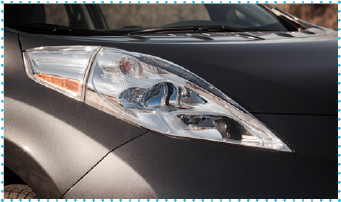
Our drive home, although the same route, on the average takes more power than the drive in, because driving home is uphill. This can take a little getting use to when judging how much power will be needed to get back to wherever your starting point was. Any drastic change in the temperature needs to be taken into account, since it can work either for or against the remaining distance that you may estimate for your human. For example, on one winter day we drove in when it was an unusual 60°F, but on the return trip the temp dropped to 35°F. The heater wasn’t used for the drive in and the headlights weren’t needed, but on the return trip both were used along with the wipers. Yes, we got rained on. Luckily on that particular day, my human was watching the changing weather patterns and plugged me in to top up my charge just enough to get us home comfortably. Weather patterns can also work in favor of our drive, and usually do, since mornings always seem to be a little colder than the evenings.
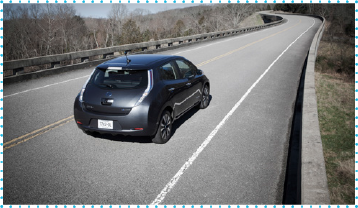
I hear the term “range anxiety” used among some humans to describe feelings of helplessness when driving near the limits of discharge; this uncertainty seems to be a real concern with them. Our confidence was gained early on while cautiously adding distance and in slowly using more and more power for accessories, while allowing for weather, etc. During the past year, our commute has started each and every day with my battery completely charged and ended with a remaining range estimate of anywhere from five miles left, to the dreaded three bars (---) and recently “Turtle Mode” (we got a little too comfortable). ![]() I say “range estimate” since what is shown on the combination meter is just that…an estimate that can change if the drive pattern changes. This has now become the “norm” (for us) and no longer evokes the anxiety that it did at this time last year since it has consistently been predictable under that particular day’s ambient conditions and drive pattern/style. Caution is still advised when driving at the limits of the indicated range.
I say “range estimate” since what is shown on the combination meter is just that…an estimate that can change if the drive pattern changes. This has now become the “norm” (for us) and no longer evokes the anxiety that it did at this time last year since it has consistently been predictable under that particular day’s ambient conditions and drive pattern/style. Caution is still advised when driving at the limits of the indicated range.
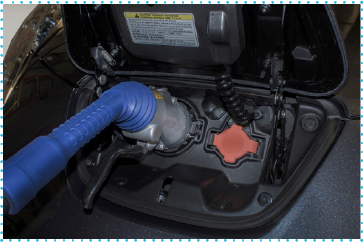
As I have already mentioned, a 220V charger is available for me at my human’s workplace, if needed, and has come in handy when indiscretion has left me without the range to get home. Unfortunately, many electric vehicles don’t have access to a 220V charger at work, but instead (if available) could possibly connect to a 120V source to top up and have enough to make a stress-free commute home, or for any possible side trips necessary. Hopefully, charging stations will continue to be installed so that you, too, have one close by.
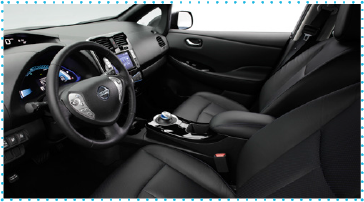
Once back in the security of my garage and plugged back into my charger, the daily cycle starts all over again. Who knows what tomorrow holds and whether or not our day’s route is longer, shorter or just the same old drive; I’ll be ready. You may think that electric vehicles, like myself, are the way of the future, or maybe are of the opinion that we are not going to pass the test of time. You may be one who enjoys the sounds of highly tuned internal combustion engines; I know that I do. Either way, whether an electric car like myself is being driven to save the planet, or to save money that would otherwise be spent on fuel along with the time lost going to the gas station, we seem to be the right tool for the job — like a favorite swivel ratchet. As an electric vehicle, I never thought that I could measure up to my trusty old fossil fueled cousins, but it looks like I may stick around for a while.
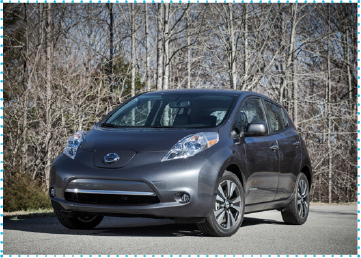
This glimpse into “A Day in the Life of a LEAF®” is meant to give you some small insight into what it is like to drive one of these unique vehicles first hand. This story gives you a look into a world that your LEAF® customer is already in and allows you to understand some of their concerns. Red’s daily drive may not be your customer’s “norm,” but some of the strategies that her human uses during their commute can also be used by your customer. Hopefully this has given you additional understanding of some of this vehicle’s driving characteristics and will allow you to relate more fully to your customer’s concerns.